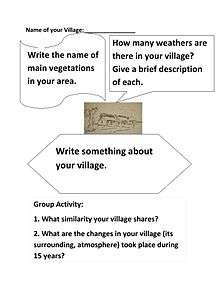Thematic learning

Thematic learning (often synonymous with thematic instruction) is an instructional method of teaching in which emphasis is given on choosing a specific theme for teaching one or many concepts. Thematic learning takes place when different disciplines are all centred towards one definite concept. This is a creative and exciting form for learners, enabling them to notice the inter-relatedness of various subjects. It is based on integrating variety of information and using it to demonstrate the topic. Pedagogy of thematic learning is based on its exploration of broad areas in one theme.[1]
Basics
Thematic learning is based on the idea that knowledge acquisition is efficient among students when they learn in the context of a coherent and holistic way and when they can associate whatever they learn to their surrounding and real life examples. Thematic instruction seeks to put the cognitive skills such as reading, thinking, memorizing, and writing in the context of a real-life situation under the broad aim to allow creative exploration.[2]
Steps
Under the thematic learning instruction, organization of curriculum can be based on Macro or Micro theme depending upon the topic to be covered. Main steps includes.[3]
- Deciding a theme: Theme can be decided by teacher and sometimes by students and it can be a smaller concept (e.g. village, mother, climate etc.) to a large and integrated system (e.g. ecosystem, atmosphere etc.)
- Integration of theme with existing curriculum: Next step of thematic learning is designing the theme in an integrative ways to existing curricula keeping the skill and content knowledge in mind.
- Designing Instructions and co-curricular plans: This step includes organizing other resources and extra-curricular activities for demonstrating the theme (e.g. field trip or visit to botanical garden).
- Group Activities and discussion: Group activities and discussion enable students to participate and reach on a shared perspective of the theme. This also helps in creative exploration of the subject.
Curriculum
For thematic learning to be successful among learners, a curriculum that is integrated is important. Thematic learning, as an integrated learning method, implies that it needs to have certain objectives in framing curriculum and plan of proceeding.
- Thematic learning consists of a curriculum that is unified and dwells on a particular topic.
- It needs to be a sound combination of various disciplines, subjects with an emphasis on projects.[4]
- The sources are not limited to textbooks.
- The curriculum needs to emphasize the explicit and implied relationship between different concepts.
- The units act as principles of organisation, with flexible schedules and flexible groups.
- The curriculum should create opportunity for the active participation of the learners in thinking and problem solving skills, observation, critical reasoning and analysis.
- It should foster experiential learning.
- The curriculum should be reflection based to help the learner think deeply and draw conclusions through various activities.[5]
Significance
Thematic learning is a newer concept in pedagogy. It is proved to be a powerful instructional method for integrating various concepts in curriculum by daily life examples and experiences. Thematic learning is geared towards accommodation of interests of individual learners and abilities. Thematic learning techniques fosters teamwork and support in the group since the group is a heterogeneous mixture being taught by a team of two facilitators. Thematic learning comprises teams with varied sizes, and work using problem solving techniques and project methods. The individual is made to progress at one's own pace, and thus develop decision making skill and responsibility.[4] Thematic learning does not have a fixed upper limit. Thematic learning helps in promoting learning with understanding and discourages rote learning.[1]
Advantages
- The method connects subjects, topics and themes naturally. Learning opportunity, thus is extended beyond one class, to throughout a whole day or week.
- Learning becomes a continuing process, which is not limited to books or guidelines prescribed by the curriculum or time bound.
- The emphasis is not on the product, but the process of learning.
- The contribution of the learners becomes an essential part of the curriculum.
- The focus of the group activity is problem solving, critical and creative thinking.
- It marks the beginning of community of learners
- Differentiation into units makes assessment accurate and relevant.
- The method enhances risk taking factor in the learners, through self-initiated learning activities and first hand experiences.
- The group consists of active learners, since there is investigation of ideas and concepts, which are a reflection of their inquiries.[6]
Outcomes
- The learner sees continuous relationship between concepts since one plans and experiences thematic inquiry.
- The learner understands the relation between topics dealt in the classroom and those one experiences outside, in day-to-day life.
- Thematic activities make the learner engage into authentic communication.
- The learner shares one's ideas with others in the group.
- Interaction within and without the group makes the learner inculcate values of respect and cooperation, thus building peer learning groups.
- A learner takes responsibility for one's learning.
- The teacher becomes the facilitator, reduces the role of dispenser of learning.
- Community for learning develops in the group.
- The assessment on the part of the facilitator and the learner oneself, becomes continuous.[4]
References
- 1 2 "Thematic Learning". Retrieved May 3, 2010.
- ↑ Robin, Fogarty (1997). Problem-Based Learning and Other Curriculum Models for the Multiple Intelligences Classroom. NY: Corwin. p. 160. ISBN 978-1-57517-067-1.
- ↑ "Improving Elementary Student Engagement in the Learning Process through Integrated Thematic Instruction" (PDF). Retrieved May 3, 2010.
- 1 2 3 "Thematic Integration" (PDF). www.paterson.k12.nj.us.
- ↑ Carol Seefeldt (2005). How to Work with Standards in the Early Childhood Classroom. Teachers College Press. pp. 47–. ISBN 978-0-8077-4587-8.
- ↑ David Booth (1 January 1998). Guiding the Reading Process: Techniques and Strategies for Successful Instruction in K-8 Classrooms. Pembroke Publishers Limited. pp. 82–. ISBN 978-1-55138-100-8.